LightCycler® 480 High Resolution Melting Master
The LightCycler® 480 High Resolution Melting Master is designed for life science research studies in combination with the LightCycler® 480, or LightCycler® 96 Real-Time PCR System. It is supplied as a ready-to-use 2x concentrated hot start reaction mix. A separate 25 mM MgCl2 Stock Solution, supplied with the master, allows users to easily optimize the Mg2+ concentration. The LightCycler® 480 High Resolution Melting Master can be used in conjunction with LightCycler® Uracil-DNA Glycosylase for carry-over prevention during PCR.
Benefits of the LightCycler® 480 High Resolution Melting Master
- Take advantage of an optimized master mix that is highly stable and robust in handling, ideally suited for use in automated workflows.
- Save time and achieve consistent, high-quality performance with a convenient, ready-to-use 2x concentrated hot start master mix.
How the LightCycler® 480 High Resolution Melting Master works
LightCycler® 480 High Resolution Melting Master is a ready-to-use reaction mix developed for the detection of DNA samples that differ in sequence from others. It contains FastStart Taq DNA Polymerase for hot start PCR, which significantly improves the specificity and sensitivity of PCR by minimizing the formation of nonspecific amplification products (Chou, Q., et al., 1992, Kellogg, D.E., et al., 1994, Birch, D.E., 1996), and LightCycler® 480 High Resolution Melting Dye for monitoring of formation and denaturation of double-stranded DNA.
FastStart Taq DNA Polymerase is a chemically modified form of thermostable recombinant Taq DNA Polymerase* that shows no activity at temperatures up to 75°C. The enzyme is active only at high temperatures, where primers do not bind nonspecifically. The enzyme is activated (by removal of blocking groups) during a single pre-incubation step (95°C, 5 – 10 minutes) before cycling begins.
LightCycler® 480 High Resolution Melting Dye is a new fluorescent dye that enables detection of sequence variations by different melting curve shape, especially if a sample is heterozygous for a particular mutation. This feature is not shared with other dyes traditionally used in real-time PCR (e.g., SYBR Green I or ethidium bromide). LightCycler® 480 High Resolution Melting Dye is not inhibitoric to amplification enzymes. Thus, high concentrations of the dye do not affect the PCR. These high concentrations completely saturate the dsDNA in the sample. dsDNA remains dye saturated during the subsequent melting experiment. Under these conditions, even single nucleotide exchanges result in subtle, but reproducibly detectable changes in melting curve shape (Wittwer, C.T., et al., 2003, Herrmann, M.G., et al., 2006).

Figure: Normalized, temp-shifted melting curves from CyP2C2 amplicons carrying a sequence variation, evaluated using the LightCycler ® 480 Gene Scanning Software. Sequence variants can be distinguished by the different shapes of the melting curves.








